Montessori Language Shelf Ideas
Looking for Montessori language shelf ideas for Montessori homeschool? We’re here to help! Here you’ll find a few of our favorite Montessori activities to promote language development in toddlers, preschoolers, and early readers.
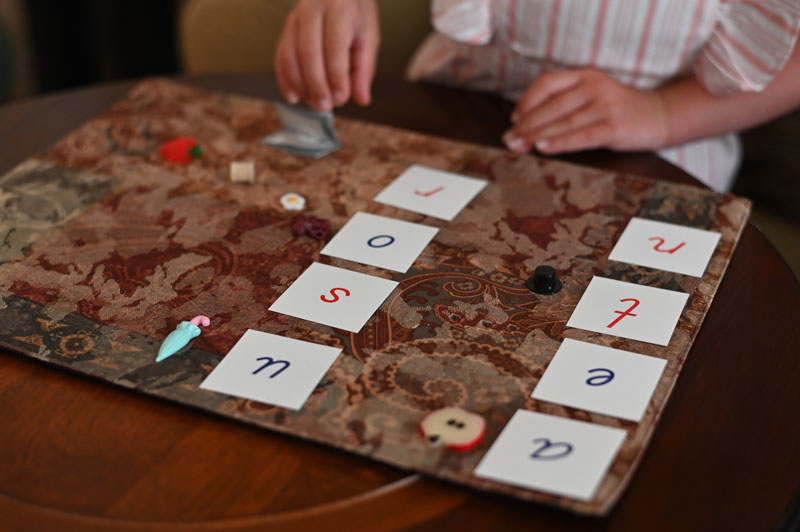
Montessori Language Shelf Ideas for Toddlers
Even though most young toddlers aren’t directly working with letters, they can still benefit immensely from Montessori language work. These ideas are perfect for pre-readers mastering their spoken language skills.
Language Basket
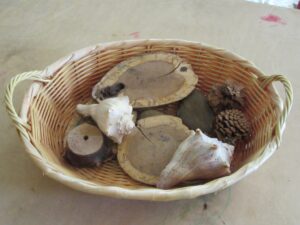
Fill a small language basket with various related language objects. These items can be dedicated language miniatures or a collection of household, nature, or food items. For example, you could fill a basket with several different types of fruit, a few kitchen tools, or various natural objects. Children can explore these items and parents can use them to introduce vocabulary as they name the objects and talk about their characteristics and uses.
Rhyming Basket
A more advanced take on a language basket for slightly older children, a rhyming basket is filled with various items with rhyming names. Children can explore each item and begin to recognize the rhyming sounds. Start with just a few objects. One basket may include a hat, cat, and bat. Another may include a truck, duck, and buck. This is a great pre-reading activity to help children recognize sounds and patterns in words.
Object-to-Picture Matching
Even young toddlers can enjoy this Montessori activity. For object-to-picture matching, present a small basket of language objects and printed images of each object. The child can then match each object with its corresponding image. As the Global Montessori Network explains, this activity helps children make the connection between objects and images of said objects.
Picture-to-Picture Matching
Once a child has mastered object-to-picture matching, they may enjoy picture-to-picture matching. Print or prepare two sets of identical pictures. Put both sets separately on a tray (a tray with a divider works great for this.) The child can match the pictures. Eventually, they may even enjoy playing a memorization game with the cards flipped over. In keeping with Montessori principles, keep the images realistic with minimal background.
Montessori Language Shelf Ideas for Preschoolers
As children master spoken language and begin to transition to work with written language, they enter a new phase of language development. These works can help support children during this transition as they prepare to read and write.
Sound Games
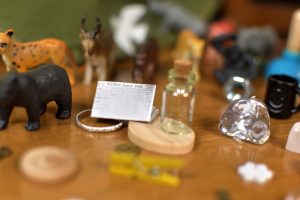
To play sound games, gather a few language miniatures with different starting sounds. Play an “I Spy” game with the miniatures, emphasizing the starting sounds. For example, you may have a basket with language miniatures of a card, mug, and apple and say, “I spy something that starts with ‘cuh.'” Once your child masters starting sounds, you can continue to play sound games focusing on the ending and middle sounds.
Sandpaper Letters
Once your child is familiar with the concrete sounds that create words, they’re ready to learn how we write the letters that correspond with the sounds. Present a few sandpaper letters on your shelf in a box or basket. Show your child how to trace each letter while also repeating the sound the letter makes. Then, your child can explore the letters on their own.
Letter Sound Basket
Create an object basket with a sandpaper letter (or movable alphabet letter) and several objects whose name starts with that letter. For example, you may put a sandpaper “b” in a basket alongside a button, banana, book, and block.
Matching Letters with Language Miniatures
Gather a few language miniatures and corresponding sandpaper letters or movable alphabet letters. Place them on a tray. Your child can practice matching each language miniature with the letter sound that the name of the object starts with.
DIY Nature Sandpaper Letters
Combine the benefits of outdoor time, practical life, and language work with tactile nature letters. Start with gathering natural materials like leaves, flower petals, or pebbles on a nature walk. On a tray, arrange glue, one natural material, and paper with a letter printed or written. Then, your child can glue the material onto the letter, creating their very own sandpaper letter.
Montessori Sand Tray
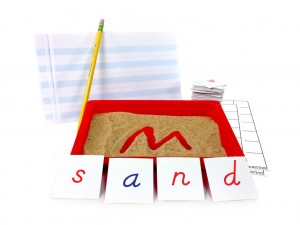
After your child has learned a few letters using sandpaper letters, they may enjoy writing the letters with a Montessori sand tray. Pour sand or salt into a tray and place a sandpaper letter next to the tray for them to copy. This gives children a tactile, accessible way to practice writing. The Montessori By Mom Learning Language Toolbox includes a sand tray, along with a sandpaper letter book, printed movable alphabet, and language miniatures.
Montessori Language Shelf Ideas for Early Readers
As your child learns to write and read, shelf work can help them practice their emerging skills and grow confident in their literacy. Here are Montessori language shelf ideas for early readers:
Three-Part Cards
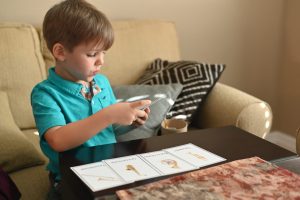
Montessori 3-part cards consist of three parts: one card with an image and label, another with just an image, and another with just a label. As children work with 3-part cards, they can build their vocabularies, classify related words, and practice their reading skills. After presenting 3-part cards, display them on a tray on your child’s shelf. Trays that divide into three sections are especially helpful for this Montessori work.
CVC Words
As soon as a child is confidently working with letters, they can begin forming simple words with sandpaper letters or movable alphabet letters. Present a language object or printed picture of an object along with the letters needed to spell the word. Start with simple CVC (consonant-vowel-consonant) words, like cat, jam, or hen. At first, you may write or print the word on a piece of paper and simply have your child recreate the word with their movable alphabet letters. Eventually, they will be ready to spell the CVC words without a printed reference.
Movable Alphabet Word Building
One approach that sets Montessori language theory apart from other approaches is that children learn to write before they read. With a movable alphabet, children can begin writing words and sentences even before they have the fine motor skill to write pencil to paper. Place a movable alphabet (either traditional, printed, or DIY) on your child’s shelf alongside a mat or rug for free writing.
Share With Us
We hope you’ve found these Montessori language shelf ideas useful. Do you have any Montessori language shelf ideas you’d add to this list? Let us know in the comments below!
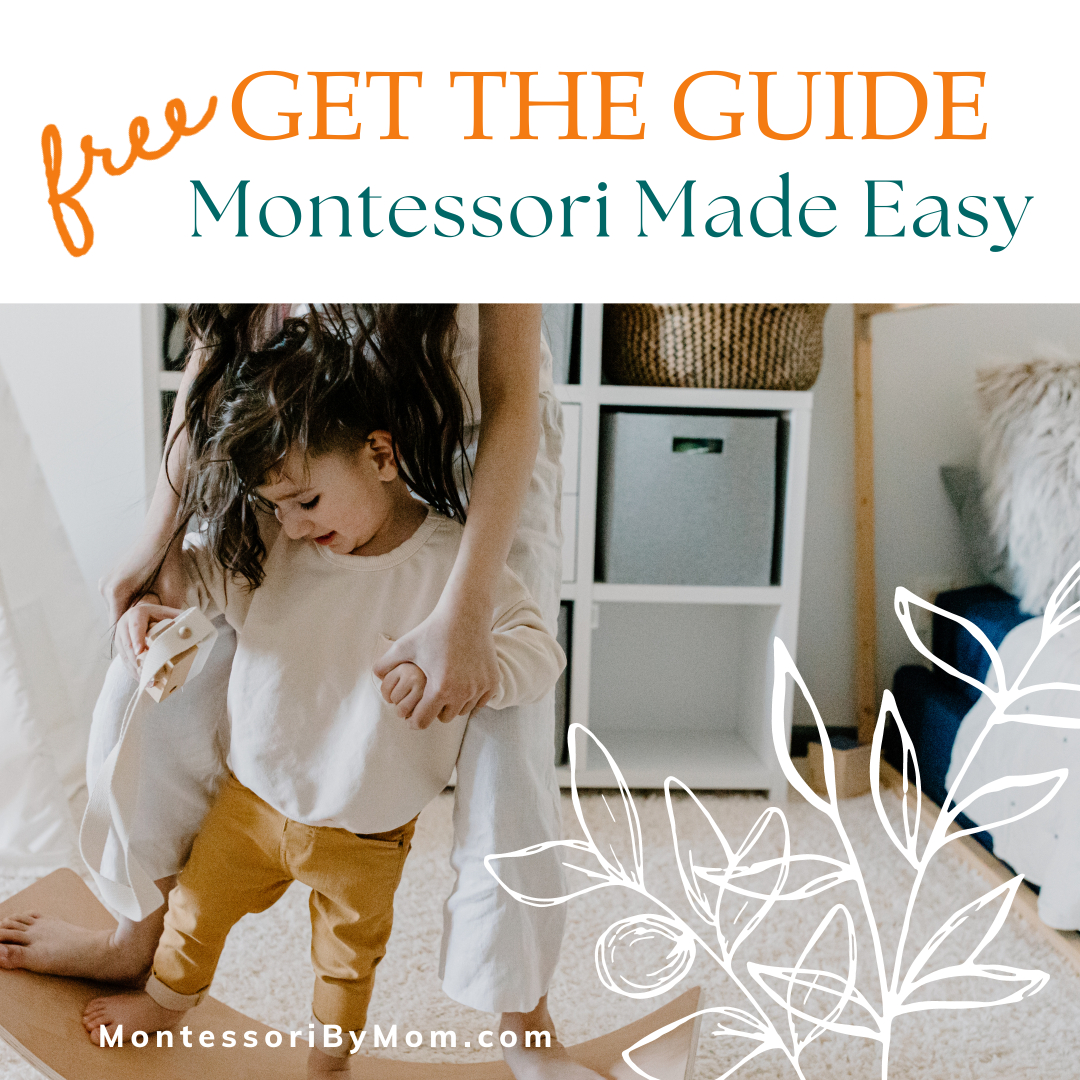


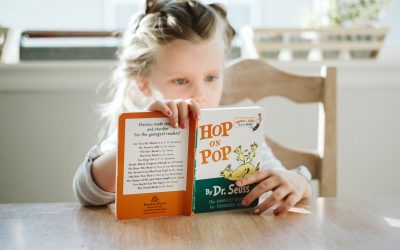
0 Comments